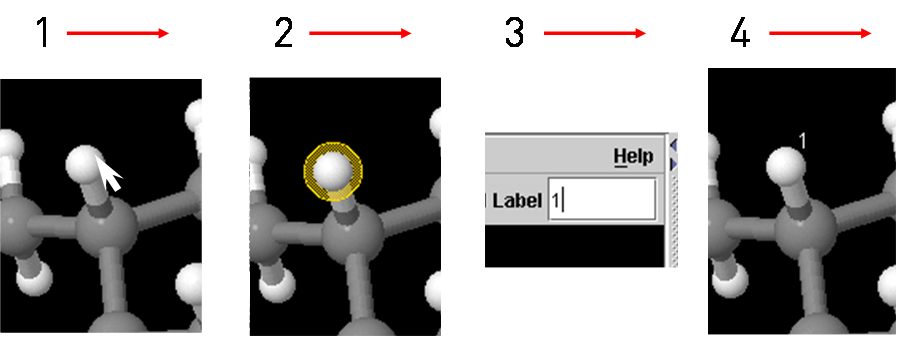Launch Janocchio. To launch as an application, double click on the "Janocchio.jar" file in the installed location. To start the applet, it is necessary simply to browse to the website where it is installed and accept the identity of the applet signer when requested.
Read in a multi-frame XYZ or SD file (File -> Open or File -> Recent Files 1) containing the isomers or conformers of interest. (NB If they are isomers, you should ensure the program used to create the file has numbered the atoms for each entry consistently.)
Step through the frames using the arrow buttons4 or by typing a frame number into the Frame box5 to confirm that your multiple structures are present. The total number of structures loaded is also shown.
Add labels to the atoms. This is not an essential step, but it is generally very helpful to use the same labels as in the original spectral assignment. Note that updating a label will automatically update all tables with the new label, as well as all structures in the set.
- Single click on the atom you want to label,
- Type the name 'Label' text box,2 and press Enter
- Press Enter: the label appears next to the atom.
Calculate NOE's for pairs of atoms
- Double-click on first atom, double-click on second atom. The calculated NOE appears in the NOE Table.
- Parameters controlling the calculation are set in the Noe Table 'Parameters' tab (see more details).
- The NOEs can be normalised to a reference NOE, selected by highlighting one row and pressing the 'Ref' button. For other option on normalization, see the 'NOE Table' 'Parameters' tab (see more details).
Calculate coupling constants for pairs of atoms
- Double-click on first atom, single-click on second and third atom in the torsion which describes the coupling, and finally double click on the fourth atom. The calculated J-value appears in the Couple Table.
- The 'Couple Table' 'Parameters' tab contains information about the J-coupling calculations, and it is possible to select the equation used for 3JCH calculations (see more details).
Type your experimental data for NOEs or coupling constants into the Exp columns.3 In the NOE table both experimental distances and experimental NOE values can be stored, by toggling the dropdown 'Exp NOE, Exp Dist' menu. It is anticipated you will use one or the other, depending on how you have acquired experimental data. For example for a NOESY. It may be easier to simply enter NOE integrals, whereas if you have a 1D NOE build up curve, it would be better to enter the derived distance. Once experimental data is entered, the cells containing the calculated values become colour-coded by the difference between the calculated and experimental values. The thresholds for this conditional formatting are controlled from the cell colours tab. (see entry on Cell Colouring)
Step through the frames as described above. Calculated NOEs and coupling constants in the tables will change to correspond to the displayed conformer, along with the colour-coding if experimental data is present.
It is possible to jump automatically to the frame with the lowest total error, by using the Analysis -> Jump to Frame with Lowest Error button. The error is summed over all experimentally determined NOEs/distances and coupling constants. The total error is displayed in the Error box (6), and the relative weights of NOEs and couplings in determining these sums can also be adjusted here.
If you want to refer back to the work later, save a janocchio NMR information file. All the data stored in Janocchio can be saved and reloaded at any time via the File -> Save NMR Data and Load Nmr Data menu options. The data files have extension .jsn (JSON format). When run as an applet, Janocchio automatically saves a .last.jsn file in the user's home directory when the applet is closed (for example by closing the browser or refreshing the page). On reloading, the Janocchio applet automatically detects the .jsn file and asks the user if they wish to load the data from the .last.jsn file.
